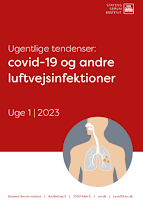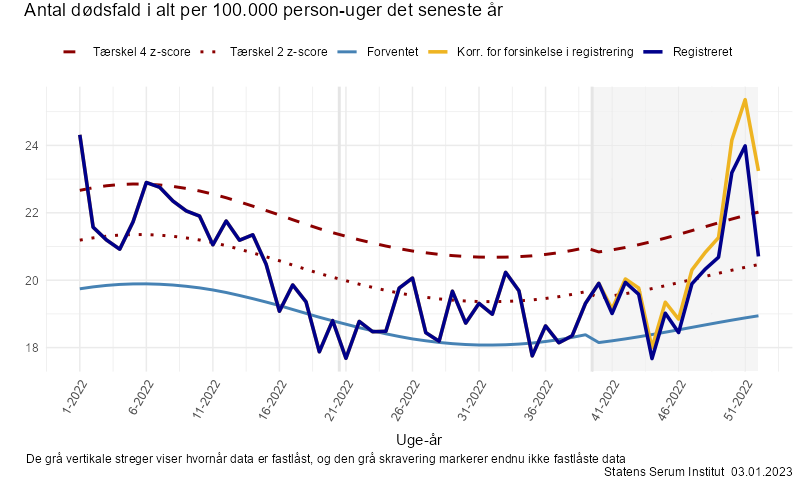
#17,213
Because of their relatively small population (5.8 million), a well-monitored universal healthcare system, and a relatively high degree of testing, Denmark is often able to provide us with valuable early data on the impact of COVID variants and other infectious diseases.
Today their SSI (Statens Serum Institut) has released new data showing a sharp increase in excess mortality - particularly in the elderly - this winter, which they ascribe to a mixture of COVID, influenza, RSV and other respiratory viruses.
Signs of excess mortality
The number of deaths in Denmark has increased significantly in recent weeks, and is now above the normal level, while at the same time cases of infection with covid-19 are falling. This shows this week's trend report from the Statens Serum Institut.
Last edited on January 5, 2023
The overall mortality rate in Denmark has increased in recent weeks, and in particular in the age group 75+, far more deaths than expected have been registered.
However, the increased mortality recorded from week 50 to week 52 may be due to several causes.
"It is a steeper curve than we normally see, and it surprises us a little. We usually see a higher mortality in the winter months, but the figures show that right now there is a higher mortality than there usually is at this time of the year", says department doctor Lasse Vestergaard from the Statens Serum Institut (SSI).
Widespread infection with infectious diseases
The increased mortality coincides with a high level of infection with both covid-19, influenza and other respiratory infections, but other factors can also play a role, explains Lasse Vestergaard.
"This is probably due to the fact that there are more respiratory infections in circulation at the moment. In addition to covid-19, we have had a high level of RS virus since the autumn, and the flu infection has also been increasing in recent weeks, especially among the elderly. Those things together can contribute to the increased mortality,' he says.
There is also an increase in the number of deaths related to covid-19.
It also appears from the trend report that the past week has seen a further increase in influenza infections and hospitalizations caused by both influenza A and influenza B. However, the infection curves are not as steep as seen in previous weeks, when we saw a new doubling in cases of infection per week, four weeks in a row. SSI expects that the number of flu infections will continue to increase in the coming time.
There is a decreasing incidence of cases of infection and hospitalizations with RSV, but the level is still high compared to the seasons that preceded covid-19.
Decrease in confirmed covid-19 cases
The number of registered covid-19 infection cases, on the other hand, fell in week 52 to 115 cases per 100,000 inhabitants from 157 cases per 10,000 inhabitants in week 51. The fall is seen in all regions and in all age groups, except for the youngest from 0-2 years.
It is noted in the report that changed patterns in both testing and admissions due to Christmas and New Year may affect monitoring data, as testing activity in that week fell by 19 percent, just as the number of new hospital admissions fell slightly, from 826 in week 51 to 801 in week 52.
However, a decrease in the positive rate indicates that the decrease in confirmed cases is real. There is also a decrease in the number of people infected in nursing homes.
There is a slight increase in the concentration of SARS-CoV-2 in the wastewater compared to previous weeks. Over the past three weeks, the average weekly growth rate nationally has been at a stable level.
The English language overview From the The trend report for week 1 - 2023
Overall assessment
The number of confirmed cases with SARS-CoV-2 has decreased in week 52 to an incidence of 1115 cases per 100,000 inhabitants. The number of confirmed cases has decreased in all. The decrease is seen in all age groups except among the youngest from 0 to 2 years old. The highest number of confirmed cases is seen among those 80 years old and above.
Even though the test rate has decreased by 19 % in week 52, the positive percentage has decreased slightly.
There is a decrease in the number of new hospital admissions with positive SARS-CoV-2 test from 826 admissions in week 51 to 801 admissions in week 52. The age groups from 70 to 89 years old still constitute the largest share of new admissions. There is still a slightly lesser proportion of the new hospital admissions who are admitted because of COVID-19 when compared to the average during the autumn, which can be explained by the increase in case numbers where a relatively bigger number of patients are admitted with COVID-19 as an incidental finding.
The number of confirmed cases with SARS-CoV-2 as well as the number of hospital admissions among nursing home residents with a positive SARS-CoV-2 test has decreased in week 52. By the end of week 52, approximately 89% of all nursing home residents have received a booster vaccination with a COVID-19 vaccine since the 15th of September.
Since the 15th of September 2022, approximately 75 % of the population above 50 years old have received a booster vaccination with a COVID-19 vaccine, and there is in week 52 still a markedly lower share of hospital admissions in this group compared to persons who are unvaccinated or not booster-vaccinated this autumn. Among the +50-year old, those who have received a booster vaccination are approximately 77% better protected against hospital admission than those who have received a 3rd dose of vaccination. The effect of booster-vaccination is independent of type of variant-updated vaccine.
The number of COVID-19 related deaths has risen to 94 deaths in week 52 compared to 76 deaths in week 51. The overall mortality in Denmark har been markedly raised over the latter couple of weeks. This mortality is especially seen in the age groups 75 to 84 years and 85+ years old.
BA.5 and it’s subvariants are still the dominant variants in Denmark. The share of the subvariant BQ.1.1 has decreased, while the share of BA.2.75 has increased in week 52. Several of the increasing subvariants share the same mutations, which makes the subvariants spread more easily compared to earlier subvariants
On a national level, a small rise in the concentration of SARS-CoV-2 in waste water samplings is seen in week 52. The last three weeks has shown a stable national weekly growth rate.
During Christmas and New Year’s, changed patterns in both test and hospital admissions can influence surveillance data. Overall, a decreasing number of confirmed cases with SARS-CoV-2 is seen alongside a decreasing test activity in week 52. However, the positive percentage has also decreased, indicating that the fall in number of confirmed cases is real. Likewise, a decrease in the number of confirmed cases among nursing home residents are seen in week 52.
There is a decrease in new hospital admissions, and it is still those from 70 to 89 years old, who constitute the largest group among new hospital admission.
There are signs of substantially raised general mortality in week 50 to 52. The mortality is especially seen among those 75+ years old and there is likewise an increase in the number of deaths related to COVID-19. The raised mortality coincides with infections with both COVID-19, influenza and other airway infections but also other factors can play a role.
The occurrence of RSV and hospitalizations related to RSV is falling, though the level is high compared to the seasons before COVID-19 were introduced
There is a continuous rise in cases and hospitalizations caused by both influenza A and influenza B but the increase is smaller than in the previous weeks
Reduced testing and reporting on COVID by governments around the world is making it increasingly difficult to gauge its impact, or to detect any new trends which may develop. As an example, this week the Netherlands announced they would no longer be publishing weekly data on COVID deaths.
- As of January 1, 2023, RIVM will no longer collect additional information. As a result, we will no longer report deaths from January 1, 2023 and the [Deceased] and [Week of Death] columns will no longer be completed.
Sadly, detailed data - such as provided by the SSI report above - is becoming harder to come by as countries attempt to `normalize' COVID.
